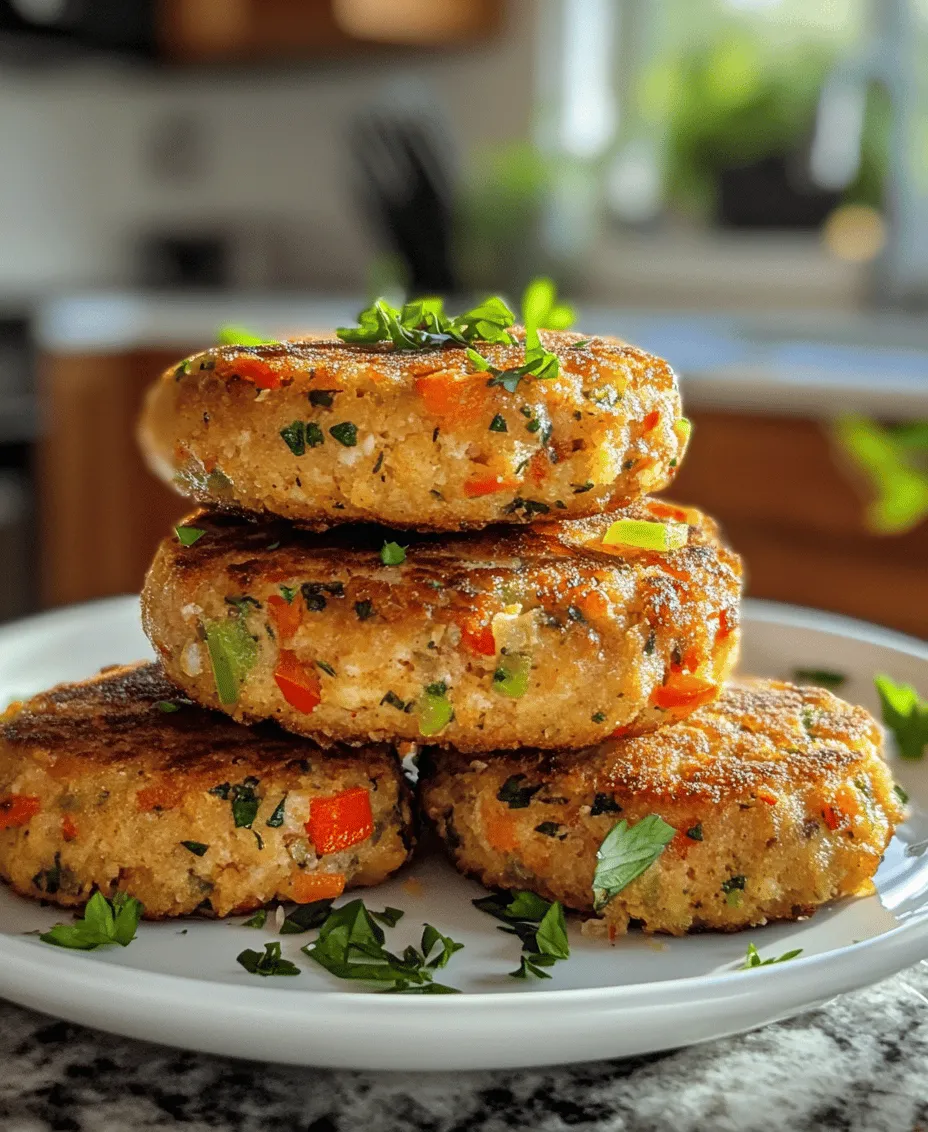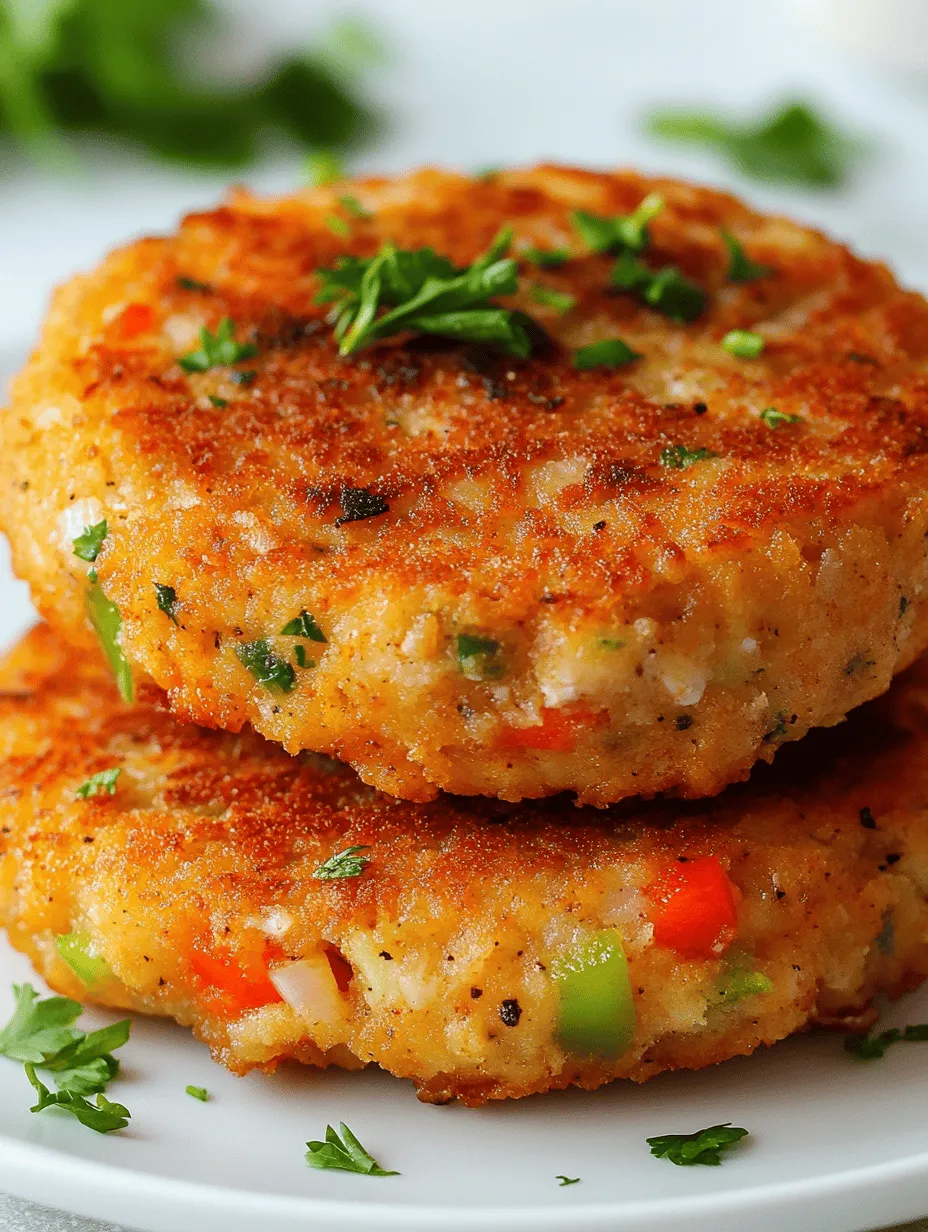Introduction
Canned salmon has become a staple in many kitchens, revered not only for its convenience and affordability but also for its impressive nutritional profile. Packed with omega-3 fatty acids, high-quality protein, and essential vitamins, canned salmon serves as a versatile ingredient that can elevate a variety of dishes. One of the most beloved ways to enjoy this pantry gem is by making quick and easy canned salmon patties.
This recipe is particularly appealing because it requires minimal ingredients and can be whipped up in no time, making it perfect for busy weeknights or casual gatherings with friends and family. Whether served as a main dish or an appetizer, these salmon patties are sure to impress with their delicious flavor and satisfying texture.
The beauty of canned salmon patties lies in their versatility. You can enjoy them on a bed of fresh greens, in a sandwich, or with a side of your favorite dipping sauce. Moreover, they can easily be adjusted to suit various dietary preferences, making them a go-to recipe for anyone looking to incorporate more seafood into their meals.
In the following sections, we will dive into the ingredients that make these salmon patties so special and provide a step-by-step guide to crafting this delightful dish.
Understanding the Ingredients
To create scrumptious canned salmon patties, it is essential to understand the role of each ingredient in the recipe. This knowledge not only helps you appreciate the dish but also allows you to make informed substitutions or modifications based on your preferences or dietary needs.
Canned Salmon
Canned salmon is the star of this recipe, providing both flavor and nutrition. It typically comes in two varieties: pink salmon and sockeye salmon. Pink salmon is milder and more delicate, while sockeye salmon boasts a richer flavor and a vibrant color. Whichever you choose, canned salmon is a protein powerhouse, offering approximately 22 grams of protein per 3-ounce serving. It is also a fantastic source of omega-3 fatty acids, which are essential for heart and brain health. Furthermore, canned salmon is ready to eat straight from the can, making it a quick and effortless ingredient for meal preparation.
Breadcrumbs
Breadcrumbs are crucial for achieving the ideal texture in salmon patties. They act as a binding agent, helping to hold the ingredients together while adding a delightful crunch when fried. There are several types of breadcrumbs to choose from, including plain, seasoned, and panko. Panko breadcrumbs, which are coarser and airier than traditional breadcrumbs, can give the patties an extra crispiness that many people find appealing. On the other hand, seasoned breadcrumbs can add additional flavor, so consider your options based on your taste preferences.
Onion and Bell Pepper
Adding finely chopped onion and bell pepper to your salmon patties enhances their flavor and adds a burst of color. Onions provide a subtle sweetness and aromatic quality, while bell peppers contribute a slight crunch and freshness. Both vegetables are nutrient-rich, offering vitamins A and C, as well as fiber. This combination not only elevates the taste of the patties but also ups the nutritional value, making them even more appealing.
Eggs
Eggs serve as the primary binding agent in this recipe, ensuring that the patties hold their shape during cooking. They also contribute a rich source of protein and healthy fats. If you’re looking for an egg substitute, you can use flaxseed meal or unsweetened applesauce, which can provide similar binding properties while accommodating dietary restrictions.
Dijon Mustard and Mayonnaise
For a touch of creaminess and tang, Dijon mustard and mayonnaise are incorporated into the mixture. Dijon mustard adds depth and a bit of heat, while mayonnaise lends moisture and richness to the patties, ensuring they remain juicy after cooking. If you prefer a lighter option, consider using Greek yogurt as a substitute for mayonnaise, which will also boost the protein content.
Garlic Powder, Salt, and Black Pepper
Seasoning is key to making flavorful salmon patties. Garlic powder adds a savory depth, while salt and black pepper enhance the overall taste. The combination of these seasonings ensures that each bite is packed with flavor. Feel free to adjust the quantities of salt and pepper to suit your personal preferences.
Oil for Frying
Choosing the right oil for frying is essential for achieving perfectly crispy salmon patties. Neutral oils, such as canola or vegetable oil, are commonly used due to their high smoke points and lack of strong flavors. Alternatively, olive oil can be used for a touch of flavor, although it has a lower smoke point. Regardless of the oil you choose, be sure to use enough to create a shallow layer in the pan for optimal frying.
Optional Garnish: Fresh Parsley
While not mandatory, a sprinkle of fresh parsley can elevate the presentation of your canned salmon patties. This garnish not only adds a pop of color but also provides a fresh, herbal note that complements the rich flavors of the dish. If you prefer, feel free to use other herbs like dill or cilantro based on your taste preferences.
Step-by-Step Guide to Making Canned Salmon Patties
Now that we have covered the essential ingredients, it’s time to dive into the preparation and cooking process. A clean and organized kitchen is the best starting point for any cooking endeavor, so let’s make sure your cooking space is ready for action.
Preparation of the Cooking Space
Before you begin making your canned salmon patties, take a moment to set up your cooking space. Gather all the ingredients and tools you will need, including a mixing bowl, a frying pan, a spatula, and utensils for measuring. Having everything within reach will make the process smoother and more enjoyable.
Next, ensure that your work surfaces are clean and free of any clutter. This not only promotes a safe cooking environment but also minimizes the chances of cross-contamination. Having a tidy kitchen can significantly enhance your cooking experience, making it more efficient and pleasant.
Mixing the Ingredients
With your cooking space prepped, it’s time to mix the ingredients for the salmon patties. Begin by draining the canned salmon thoroughly and placing it in a mixing bowl. Use a fork to break it apart gently, ensuring there are no large chunks remaining. This step is crucial for achieving a consistent texture throughout the patties.
Next, add the breadcrumbs to the bowl, followed by the finely chopped onion and bell pepper. Incorporate the eggs, Dijon mustard, and mayonnaise into the mixture, along with the garlic powder, salt, and black pepper.
When mixing, it’s important to combine the ingredients without overmixing. Overmixing can lead to tough patties, so gently fold the ingredients together until they are just combined. The mixture should hold together but still have a bit of texture. If it seems too dry, you can add a little more mayonnaise or a splash of water to help bind it.
Once your mixture is ready, it’s time to shape the patties. Use your hands to form evenly sized patties, about 2-3 inches in diameter and about half an inch thick. This size ensures that they cook evenly and achieve that perfect golden-brown crust.
With the patties formed, you’re now ready to move on to the cooking process, where the magic truly happens. Stay tuned for the next part of the recipe, where we’ll guide you through frying these delicious salmon patties to perfection.

Forming Patties: Techniques for Uniform Size and Shape
Creating uniform salmon patties not only ensures even cooking but also enhances the presentation of your dish. Here are some effective techniques for forming your patties:
1. Measure Using a Scoop: Utilize a standard ice cream or cookie scoop to portion out the salmon mixture. This tool provides consistency in size, making it easier to cook the patties evenly.
2. Wet Your Hands: Before handling the salmon mixture, wet your hands with water. This prevents sticking and allows you to shape the patties without the mixture clinging to your fingers.
3. Gentle Pressing: When forming the patties, gently press the mixture into a flat disc shape. Aim for about 1 inch thick for optimal cooking. Avoid overworking the mixture to maintain a tender texture.
4. Chill Before Cooking: After forming the patties, place them on a plate or baking sheet and refrigerate for at least 15 minutes. Chilling helps the patties hold their shape during cooking.
Cooking the Patties: Best Practices for Frying
Frying the salmon patties to perfection requires attention to detail, particularly regarding oil temperature and flipping techniques:
1. Choose the Right Oil: For frying, use oils with a high smoke point, such as canola, vegetable, or avocado oil. This ensures the oil can withstand the heat without burning.
2. Heat the Oil: Preheat your skillet on medium heat and add enough oil to cover the bottom of the pan. The oil should shimmer when it’s hot enough. You can test the temperature by dropping a small amount of the salmon mixture into the oil; it should sizzle upon contact.
3. Cook in Batches: Avoid overcrowding the pan as this reduces the oil temperature, causing the patties to steam rather than fry. Cook in batches, allowing space between each patty.
4. Flipping Techniques: Use a spatula to gently lift the patties and flip them. Wait until the edges of the patties are golden brown before attempting to flip. This typically takes about 3-4 minutes per side.
5. Drain Excess Oil: Once cooked, transfer the patties to a paper towel-lined plate to absorb any excess oil, enhancing their health benefits and overall taste.
Draining and Serving: Presentation Tips
Properly draining your salmon patties not only makes them healthier but also improves their presentation:
1. Drain on Paper Towels: After cooking, place the patties on a plate lined with paper towels. This helps absorb any remaining oil without sogginess.
2. Garnish for Presentation: Consider garnishing your salmon patties with fresh herbs like dill or parsley. A wedge of lemon on the side adds a pop of color and freshness.
3. Serving Arrangement: Arrange the patties on a serving platter. You can serve them with a colorful salad or alongside roasted vegetables for a balanced meal.
Nutritional Benefits of Canned Salmon Patties
Canned salmon is a nutritional powerhouse, making these patties not only delicious but beneficial to your health:
1. Rich in Omega-3 Fatty Acids: Salmon is an excellent source of omega-3 fatty acids, which are essential for heart health and brain function. Regular consumption can help reduce inflammation and lower the risk of chronic diseases.
2. High in Protein: These patties are packed with protein, making them a satisfying meal or snack option. Protein is vital for muscle repair, immune function, and overall energy levels.
3. Packed with Vitamins: Canned salmon is rich in essential vitamins such as B12, which supports nerve function and energy production, and vitamin D, which is crucial for bone health.
4. Homemade vs. Store-Bought: Making your own salmon patties allows you to control the ingredients, avoiding preservatives and unhealthy additives often found in store-bought options. Homemade patties tend to be fresher and more flavorful.
5. Dietary Considerations: The flexibility of this recipe accommodates various dietary needs. For gluten-free options, substitute breadcrumbs with almond flour or gluten-free breadcrumbs. For low-carb variations, consider using mashed cauliflower as a binder instead of breadcrumbs.
Serving Suggestions and Pairings
Pairing your canned salmon patties with the right sides and dips can elevate your meal:
1. Ideal Accompaniments: Serve your patties with a side salad of mixed greens, cherry tomatoes, and cucumbers dressed with light vinaigrette. Alternatively, roasted vegetables or quinoa can complement the flavors beautifully.
2. Dipping Sauces: Enhance your meal with delicious dipping sauces. Classic tartar sauce, zesty lemon aioli, or a refreshing yogurt-based dip can add a delightful touch. To make a quick tartar sauce, mix mayonnaise with diced pickles, capers, and a splash of lemon juice.
3. Creative Serving Ideas: Consider turning your salmon patties into sliders by placing them on mini buns with lettuce and tomato. They also work wonderfully as a brunch item; pair them with poached eggs and avocado for an indulgent twist.
Storage and Reheating Instructions
To maximize the lifespan of your salmon patties while maintaining their flavor, follow these storage and reheating tips:
1. Storing Leftovers: If you have leftover patties, store them in an airtight container in the refrigerator for up to 3 days. For longer storage, you can freeze them. Place patties in a single layer on a baking sheet and freeze until solid, then transfer to a freezer bag.
2. Reheating Methods: When you’re ready to enjoy your leftovers, reheating can be done in several ways:
– Oven: Preheat your oven to 350°F (175°C) and place the patties on a baking sheet. Heat for about 10-15 minutes or until warmed through.
– Skillet: Heat a small amount of oil in a skillet over medium heat. Cook each patty for 3-4 minutes on each side until heated.
– Microwave: For a quick option, place a patty on a microwave-safe plate and cover it with a damp paper towel to retain moisture. Heat in 30-second intervals until warm.
Conclusion
Canned salmon patties are a versatile, quick, and nutritious option for any meal. Their ease of preparation, combined with the rich flavors of salmon, makes them an excellent choice for busy weeknights or casual gatherings. By trying this recipe, you not only save time but also enjoy the health benefits of salmon, including its omega-3 fatty acids and high protein content.
Embrace the flexibility of this dish, making it your own with various sides, dips, and serving styles. Whether you decide to serve them as a main course or part of a larger spread, these salmon patties are sure to impress and satisfy. Enjoy the delicious taste and the knowledge that you’re creating a wholesome meal with simple ingredients.


Where are the amounts needed for the ingredients
Where’s the recipe?
This recipe is impossible to follow. There are no amounts of any of the ingredients. There is information about everything one could possibly imagine except the actual amounts. It looks delicious but what the heck.